- ARRIVAL KILIMANJARO
Arrival Kilimanjaro international airport Meet & Greet our representative then transfer to your hotel for check-inn and equipment check-up following with briefing from your chief mountain guide and orientation at the city if time allow then dinner and overnight full board.



- KNOW BEFORE YOU GO - CLICK BELLOW
Precaution
- Our staff abides by the Standard Operating Procedures to prevent clients from exposure to novel coronavirus (COVID-19) while in the country.
- Our guides are highly experienced in preventing, detecting, and treating altitude sickness because they handle over 1,000 climbers per year.
- Our guides conduct twice-daily health checks using a pulse oximeter to monitor your oxygen saturation and pulse rate.
- Our guides administer the Lake Louise Scoring System(LLSS) to help determine whether you have symptoms of altitude sickness and their severity.
- Our guides are certified Wilderness First Responders(WFR). They have the tools to make critical medical and evacuation decisions on location.
- Our staff carries bottled oxygen on all climbs and can administer it to quickly treat climbers with moderate and serious altitude sickness.
- Our staff carries a portable stretcher on northern routes to evacuate climbers who need to descend but are unable to walk on their own. Wheeled stretchers provided by the park are available on other routes.
- Our staff has the ability to initiate helicopter evacuation through Kilimanjaro Search and Rescue (SAR), a helicopter rescue operation.
- Our staff carries a first aid kit to treat minor scrapes, cuts, and blisters.
What Are the Entry Requirements for Tanzania?
Foreigners seeking to enter the United Republic of Tanzania should be in possession of a valid passport, at least six months prior to expiration. The passport is to be presented to the Immigration Control Officer at any entry point: border station, airport, harbor. The passport must be presented along with one of the following:
- A valid visa
- Resident permit
- A pass
A visitor must also present an onward or return ticket together with proof that the visitor has sufficient funds to support himself or herself while in Tanzania.
All foreigners from non-Commonwealth countries are required to have a valid visa unless their countries have agreements with Tanzania under which the visa requirement is waived. Exemptions: Citizens of Commonwealth countries are not required to obtain visas unless they are citizens of the United Kingdom, Canada, Nigeria, or India.
The visa is permission granted to a foreigner who intends to travel to Tanzania on business, for a holiday, to study or conduct research, or for other approved activities. When entering Tanzania, the visitor with a visa may then obtain from the immigration control officer, a pass or any other authority to enter the country.
Visas are issued by the following:
- The office of the Director of Immigration Services, Dar es Salaam, and the office of the Principal Immigration Officer, Zanzibar.
- Tanzanian representatives abroad: Visas can be obtained at Tanzanian Embassies and High Commissions, such as the Tanzanian Embassy of the United States.
- Entry points to the United Republic of Tanzania: principally Namanga, Tunduma, Sirari, Horohoro, Kigoma port, Dar es Salaam International Airport, Kilimanjaro International Airport, Zanzibar Harbour, and Zanzibar Airport.
- Any other gazetted entry point.
At Kilimanjaro Airport, passengers disembark their flights outside on the tarmac. You may be required to show your boarding pass to staff outside the airport for verification that you got off the plane at the correct destination, so keep your boarding pass handy.
Upon entering the airport (which would be from the left side of the photo), there are several lines for visitors who have their visas and lines for visitors who need to purchase their visas. Pay attention to all open booths as the airport staff are not very helpful in directing the crowd to open lines.
You should have received a declaration form to fill out from the airline staff. If not, there are forms available inside the building. The declaration card is shown below and can be downloaded ONLINE. You will need to submit this form to immigration.
Should I Get a Medical Check Up?
All climbers should have a medical check prior to attempting the mountain. Ask your doctor if high altitude trekking is permissible for your age, fitness level, and health condition. Ask if you have any preexisting medical conditions that can cause problems on the climb. Ask if any of your medications can affect altitude acclimatization. Ask whether Diamox can be taken with your existing prescription medicines.
If you have any medical issues that can be make climbing Kilimanjaro more dangerous for you than the average person, we need to be informed of this before you make a reservation.
Such medical issues include but are not limited to: spine problems; circulation problems; internal problems such as diabetes, hypoglycemia, intestinal or kidney problems; respiratory issues such as asthma; high or low blood pressure; head trauma or injury; heart conditions; blood disease; hearing or vision impairment; cancer; seizure disorders; joint dislocations; sprains; hernia.
The minimum age for climbing Mount Kilimanjaro is 10 years old. There is no maximum age. However, the climb is strenuous and presents health risks, especially to people in high-risk categories. Serious consideration should be given to anyone under the age of 18 and over the age of 60. The climbers on the extreme ends of the age spectrum should definitely consult their doctor.
Our minimum fitness requirements are that each climber must have a resting heart rate of under 100 beats per minute. We will check your resting heart rate before your climb. If your resting heart rate is above 100, you will be required to see a local doctor prior to the climb to get approval. The average resting heart rate is 60-80 beats per minute.
What Vaccinations, Immunizations and Medications Do I Need?
Recommended Vaccinations and Preventive Medications
The following vaccines may be recommended for your travel to East Africa. Discuss your travel plans and personal health with a healthcare provider to determine which vaccines you will need.
- Hepatitis A or immune globulin (IG). Transmission of hepatitis A virus can occur through direct person-to-person contact; through exposure to contaminated water, ice, or shellfish harvested in contaminated water; or from fruits, vegetables, or other foods that are eaten uncooked and that were contaminated during harvesting or subsequent handling.
- Hepatitis B, especially if you might be exposed to blood or body fluids (for example, health-care workers), have sexual contact with the local population, or be exposed through medical treatment. Hepatitis B vaccine is now recommended for all infants and for children ages 11-12 years who did not receive the series as infants.
- Malaria: your risk of malaria may be high in all countries in East Africa, including cities. See your health care provider for a prescription antimalarial drug.
- Meningococcal (meningitis) if you plan to visit countries in this region that experience epidemics of meningococcal disease during December through June.
- Rabies, pre-exposure vaccination, if you might have extensive unprotected outdoor exposure in rural areas, such as might occur during camping, hiking, or bicycling, or engaging in certain occupational activities.
- Typhoid vaccine. Typhoid fever can be contracted through contaminated drinking water or food, or by eating food or drinking beverages that have been handled by a person who is infected. Large outbreaks are most often related to fecal contamination of water supplies or foods sold by street vendors
- Yellow fever, a viral disease that occurs primarily in sub-Saharan Africa and tropical South America, is transmitted to humans through the bite of infected mosquitoes. The virus is also present in Panama and Trinidad and Tobago. Yellow fever vaccination is recommended for travelers to endemic areas and may be required to cross certain international borders (For country-specific requirements, see Yellow Fever Vaccine Requirements and Information on Malaria Risk and Prophylaxis, by Country.). Vaccination should be given 10 days before travel and at 10-year intervals if there is an ongoing risk.
- As needed, booster doses for tetanus-diphtheria, measles, and a one-time dose of polio vaccine for adults.
Malaria
Malaria is always a serious disease and may be a deadly illness. Humans get malaria from the bite of a mosquito infected with the parasite. Your risk of malaria may be high in all countries in East Africa, including cities. All travelers to East Africa, including infants, children, and former residents of East Africa, may be at risk for malaria. Prevent this serious disease by seeing your health care provider for a prescription antimalarial drug and by protecting yourself against mosquito bites.
All travelers should take one of the following drugs:
- atovaquone/proguanil,
- doxycycline,
- mefloquine, or
- primaquine (in special circumstances).
Yellow Fever
A certificate of yellow fever vaccination is required for entry into Tanzania when arriving from countries where yellow fever is present.
Food and Waterborne Diseases
Make sure your food and drinking water are safe. Food and waterborne diseases are the primary cause of illness in travelers. Travelers’ diarrhea can be caused by viruses, bacteria, or parasites, which are found throughout East Africa and can contaminate food or water. Infections may cause diarrhea and vomiting (E. coli, Salmonella, cholera, and parasites), fever (typhoid fever and toxoplasmosis), or liver damage (hepatitis).
To stay healthy, do…
- Wash your hands often with soap and water or, if hands are not visibly soiled, use a waterless, alcohol-based hand rub to remove potentially infectious materials from your skin and help prevent disease transmission.
- In developing countries, drink only bottled or boiled water, or carbonated (bubbly) drinks in cans or bottles. Avoid tap water, fountain drinks, and ice cubes. If this is not possible, learn how to make water safer to drink.
- Take your malaria prevention medication before, during, and after travel, as directed. (See your health care provider for a prescription.)
- To prevent fungal and parasitic infections, keep feet clean and dry, and do not go barefoot, even on beaches.
- Always use latex condoms to reduce the risk of HIV and other sexually transmitted diseases.
- Protect yourself from mosquito insect bites:
- Wear long-sleeved shirts, long pants, and hats when outdoors.
- Use insect repellents that contain DEET (N, N-diethyl methyl toluamide).
- If no screening or air conditioning is available: use a pyrethrum-containing spray in living and sleeping areas during evening and nighttime hours; sleep under bed nets, preferably insecticide-treated ones.
Do not…
- Do not eat food purchased from street vendors or food that is not well cooked to reduce the risk of infection (i.e., hepatitis A and typhoid fever).
- Do not drink beverages with ice.
- Avoid dairy products, unless you know they have been pasteurized.
- Do not swim in freshwater to avoid exposure to certain water-borne diseases such as schistosomiasis.
- Do not handle animals, especially monkeys, dogs, and cats, to avoid bites and serious diseases (including rabies and plague). Consider pre-exposure rabies vaccination if you might have extensive unprotected outdoor exposure in rural areas.
- Do not share needles for tattoos, body piercing or injections to prevent infections such as HIV and hepatitis B.
- Avoid poultry farms, bird markets, and other places where live poultry is raised or kept.
- FULL DAY RESTING DAY



- All - Inclusive
- Alcohol
- MARANGU - GATE TO MANDARA HUT
Elevation (ft): 6,046 ft to 8,858 ft
Distance: 8 km/5 miles
Hiking Time: 4-5 hours
Habitat: Rain Forest
We depart Moshi for Marangu Gate for the necessary formalities before beginning our trek. The hiking trail begins by ascending a beautiful, tropical rainforest.
At the upper edge of the forest line, we have the opportunity to see blue monkeys. The trail then widens to expose beautiful hillsides until we reach Mandara Hut.
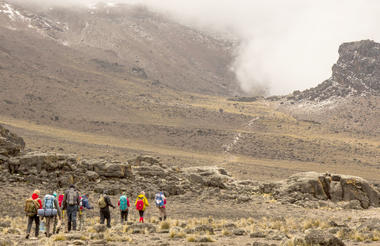
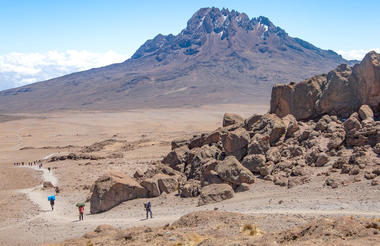
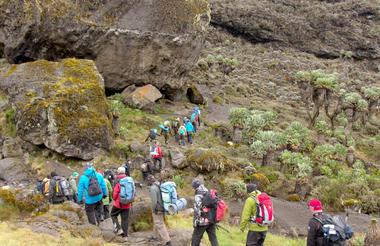
- KILIMANJARO GEARS CHECKLIST
Technical Clothing
- Waterproof Jacket, breathable with hood
- Insulated Jacket, synthetic or down, warm
- Soft Jacket, fleece or soft-shell
- Long Sleeve Shirt, light-weight, moisture-wicking fabric
- Short-Sleeve Shirt, light-weight, moisture-wicking fabric
- Waterproof Pants, breathable (side zipper recommended)
- Hiking Pants
- Fleece Pants
- Shorts (optional)
- Long Underwear, moisture-wicking fabric
- Underwear, moisture-wicking fabric recommended
- Sports Bra (women)
Headwear
- Brimmed Hat, for sun protection
- Knit Hat, for warmth
- Balaclava or Buff (recommended)
Handwear
- Gloves, warm (waterproof recommended)
- Gloves, light
Footwear
- Hiking Boots or Shoes, warm, waterproof
- Socks, wool, or synthetic
- Gaiters, waterproof (optional)
Accessories
- Sunglasses or Goggles
- Backpack Cover, waterproof (optional)
- Water Bottle(Nalgene, 32 oz.)
- Water Bladder (Camelback type, 3 liters)
- Towel, lightweight, quick-dry (optional)
- Pee Bottle, to avoid leaving tent at night (recommended)
- Stuff Sacks, Dry Bags, or “Ziploc”-Type Plastic Bags, to keep gear dry and separate. Note that
- there is a general ban on plastic bags in Tanzania; however Ziploc-type bags for toiletries are permitted for tourists
Paperwork
- Trip Receipt
- Passport
- Visa (available at JRO)
- Immunization Papers
- Insurance Documents
- All-Inclusive
- Alcohol
- MANDARA HUT - HOROMBO HUT
Mandara Hut to Horombo Hut
Elevation (ft): 8,858 ft to 12,205 ft
Distance: 12 km/7 miles
Hiking Time: 6-8 hours
Habitat: Heath
We start the day continuing through the forest until the trail opens into high moorland. We may get our first views of Kibo and Mawenzi peaks – two of the three volcanic peaks that make up the summit of Kilimanjaro.
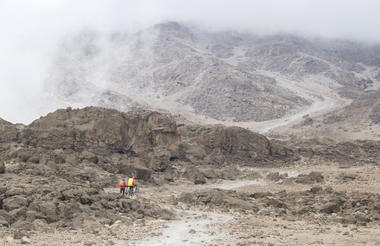
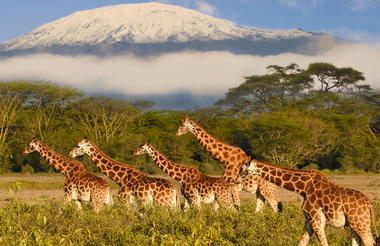
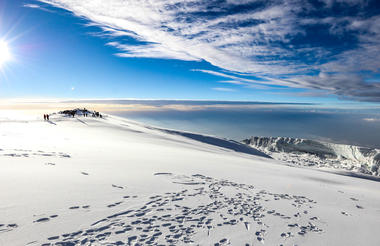
- THE BEST TIME TO CLIMB MOUNT KILIMANJARO
Precaution
The mountain can be climbed all year round. The main trekking seasons on Kilimanjaro correspond with the mountain’s two ‘dry’ seasons. These are January to mid-March and June to October. Note that it will still probably rain on your trek during these months too – it’s rare to climb without getting rained on at least once.
Of course, you can climb in the rainy season too (the wet seasons are April-May, which is often called the ‘long rainy season’ or simply the ‘long rains’ and November-mid-December). But of course, the weather conditions may not be ideal and there is a much higher chance you’ll encounter rain. The summits of Kibo and Mawenzi are likely to be wreathed in thick clouds too. Indeed, several agencies even suspend their operations in November and December.]
It’s true that visibility is less at this time though we take issue with those companies that say that your chances of reaching the summit are significantly lower too; that simply isn’t the case. True, once every couple of years or so there may be too much snow, blocking you from reaching the summit. But this is rare. So as long as you are dressed for the conditions then, in our experience, you’ve got just as good a chance of getting to the summit.
Curiously, Christmas and New Year, when the weather is far from perfect, are actually among the most popular times for climbing Kilimanjaro.
The following graph gives you an idea of the average temperature on Kilimanjaro at various times of the year.
As to the relative merits of the two Kilimanjaro trekking seasons, the differences are small although significant:
From January-to-March trekking season
The January to March season tends to be (slightly) colder and there is a much greater chance of snow on the path at this time. The days, however, are often clearer, with only the occasional brief shower. It is usually an exceptionally beautiful time to climb and is often a little quieter than the other peak season of June to October, which coincides with the main academic holidays in Europe and the West. In this latter season, the clouds tend to hang around the tree-line following the heavy rains of March to May. Once above this altitude, however, the skies are blue and brilliant and the chance of precipitation minimal (though still present).
The following graph shows the average snowfall on Kilimanjaro throughout the year.
Full Moon and New Moon Trekking.
We like to offer Full Moon Kilimanjaro treks as part of our trek schedule. We do this because we realize that the final push up the slopes of Kibo to the summit -a walk that is traditionally done at night – is best done under the light of a full moon. Visibility is that much greater, of course. There are also those who say that the weather during the full moon period is more settled and calm.
These full moon treks are very popular – some would say too popular, and if you want to enjoy the advantages provided by the full moon, but want to avoid the (imaginary) crowds, then you can always choose to climb a day or two later or earlier.
If the Full Moon doesn’t appeal, then how about a New Moon Kilimanjaro climb? After all, one of the chief pleasures of a Kilimanjaro climb is to gaze up at the stars. The lack of light pollution and the height that you are sleeping at means the Heavens are just spectacular. By choosing to climb over a New Moon, the light reflected from the Moon to the Earth is at its lowest, allowing you to see the stars at their brilliant best! It’s certainly a great time to climb.
What is a Typical Day's Schedule?
On a typical day on the mountain, you will be awakened from your tent around 6:30 AM by a staff member. Hot drinks will be available in the mess tent at this time while breakfast will be served around 7:00 AM. Before eating breakfast, you should pack your day pack and duffer bag and bring them outside of the tent so the porters can take down the tent.
Meals are served in a mess tent or occasionally outdoors if the weather is nice – complete with chairs, tables, dinnerware, and silverware. You usually begin walking around 8:00 AM, while the porters stay behind to clean up the campsite and pack up the tents and other equipment. A health check will also be performed in the morning.
While the hours vary from day to day, your average walking time will be around four to six hours per day. During the walk, your guide will decide the pace and when to take a break depending on his assessment of the party’s performance. The porters consistently move ahead of the group in order to prepare food, collect water, and set up tents so that everything is ready when the party arrives. A hot lunch is served partway through your day’s trek through on occasion a boxed lunch may be provided.
Once you arrive at the campsite, snacks are served. Then, dinner is served around 6:00 PM. Another health check is performed in the evening. The guide will discuss the next day’s events with the group after dinner. Downtime is spent chatting with your fellow climbers, staff, and others sharing the campsite, reading, or otherwise relaxing.
Summit Day
Summit day is a tough, 11 to 16 hour day. This monumental effort is what makes climbing Kilimanjaro an achievement. It begins very early as guides try to time their trekking party to reach Uhuru Point at sunrise. Climbers go to sleep after an early dinner the night before and are awoken around midnight to prepare for the summit attempt. After a light snack, climbers ascend in the darkness, cold, and wind. It goes without saying that under these conditions, climbing is difficult, especially on loose rock and up a very steep slope. This is where your physical prowess and mental toughness will be tested.
Our team of Booking Kilimanjaro guides will be with you every step of the way to assist you during your ascent. Short breaks, usually lasting less than ten minutes, will be taken along the way for a quick snack and drink. This is to make sure the climbers stay energized and hydrated but do not get cold by sitting still. The guides will regularly check to see how everyone is feeling and offer a hand to those who may need extra help.
It is possible that someone may have to turn around on the mountain due to altitude sickness, exhaustion, or a variety of other matters. Each group will have a lead guide, a number of assistant guides depending on the party size, and summit porters – all of whom are able to escort climbers down. Therefore, if a person cannot continue the ascent, one of the staff members will accompany this climber while the lead guide takes the group onward. The remaining party is unaffected and continues their climb as scheduled.
Once you reach the summit, some time is spent celebrating and taking photos, before returning to high camp, either Barafu or Kibo Hut. There, you eat lunch and regain your strength before continuing the descent to a much lower camp. The long descent immediately after the summit is where most people get tired, due to the partial night’s sleep, the expenditure of energy required to reach the top, and the particularly long-distance covered that day. This is completely normal. For those who may be feeling ill from the altitude, getting to this lower elevation can relieve symptoms often quickly and completely.
Altitude and Kilimanjaro Acclimatization
How one reacts to high altitude is uncertain. Some people’s bodies adjust well to the decreased oxygen levels; others do not. Being physically fit and in good health, although helpful, is no guarantee of your ability to acclimatize. Therefore the best advice we can give is to take 7 or more days on the mountain and to follow our acclimatization guidelines.
There is a strong correlation between the amount of time spent on the mountain and the summit success rate. Because the human body adapts to high altitude slowly, the more time it has, the better the chances of acclimatization.
A successful summit is usually a question of how well a climber can acclimatize to the high altitude, rather than the climber’s ability to ascend. By trekking standards, most of the day hikes on Kilimanjaro are not very strenuous. The big exception to this is the summit attempt, which requires tremendous effort and is hard for nearly everyone. Climbers who acclimatize well to the altitude have a great chance of making it to the top.
Where Will I Sleep?
Climbers will sleep in state-of-the-art, four-season mountain tents during the trek. Our Mountain Hard wear tents are warm, waterproof, and roomy – perfectly suited for your Kilimanjaro adventure. We understand that some climbers are anxious about camping for so many days, so we aim to have them be as dry, warm, and comfortable as possible.
Mountain Hardware Lamina -30F sleeping bags are available for rent on location in Tanzania. These warm, winter synthetic sleeping bags are constructed to enhance loft and eliminate cold spots. The durable nylon shell repels water while the polyester lining wicks away moisture, keeping weary climbers dry and warm.
The Lamina is long enough to fit someone 6′ 6″ tall, weighs 5 lbs 14 oz. and is temperature rated to -30F (-34C), more than sufficient even for Kilimanjaro’s chilly nights. They are washed after every use and rented for only a short period before they are removed from the rental inventory.
- All -Inclusive
- Alcohol
- HOROMBO HUT - MAWENZI RIDGE
Horombo Hut to Mawenzi Ridge
Elevation (ft): 12,205 ft to 14,400 ft
Distance: 5 km/3 miles
Hiking Time: 2-3 hours
Habitat: Heath
Mawenzi Ridge to Horombo Hut
Elevation (ft): 14,400 ft to 12,205
Distance: 5 km/3 miles
Hiking Time: 1-2 hours
Habitat: Heath
This is an extra day meant for acclimatization and can be spent day hiking on Mawenzi Ridge. The unique landscape offers motivating views of Kibo and Mawenzi. After spending a few moments exploring the area we head back to Horombo Hut, for dinner and overnight.
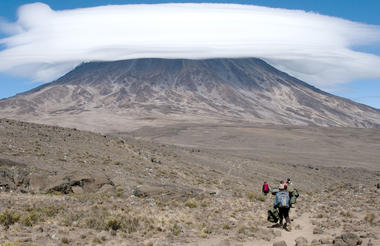
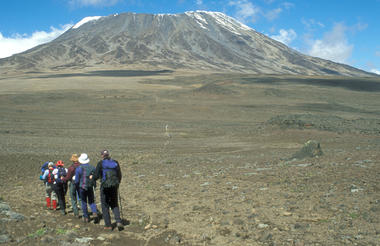
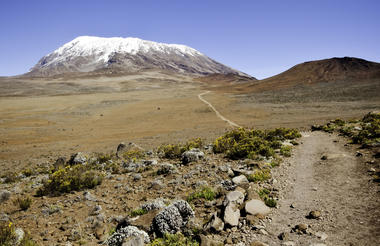
- HOROMBO HUT - MAWENZI RIDGE
Horombo Hut to Mawenzi Ridge
Elevation (ft): 12,205 ft to 14,400 ft
Distance: 5 km/3 miles
Hiking Time: 2-3 hours
Habitat: Heath
Mawenzi Ridge to Horombo Hut
Elevation (ft): 14,400 ft to 12,205
Distance: 5 km/3 miles
Hiking Time: 1-2 hours
Habitat: Heath
This is an extra day meant for acclimatization and can be spent day hiking on Mawenzi Ridge. The unique landscape offers motivating views of Kibo and Mawenzi. After spending a few moments exploring the area we head back to Horombo Hut, for dinner and overnight.
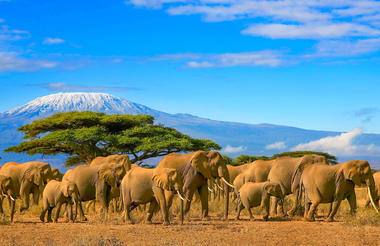


- All-Inclusive
- Alcohol
- KIBO HUT- UHURU PEAK - HOROMBO HUT
Kibo Hut to Uhuru Peak
Elevation (ft): 15,430 ft to 19,341 ft
Distance: 6 km/4 miles
Hiking Time: 6-8 hours
Habitat: Arctic
Uhuru Peak to Horombo Hut
Elevation (ft): 19,341 ft to 12,250 ft
Distance: 16 km/10 miles
Hiking Time: 4-5 hours
Habitat: Heath
Very early in the morning (around midnight), we begin our push to the summit. This is the most mentally and physically challenging portion of the trek. The wind and cold at this elevation and time of day can be extreme. We ascend in the darkness for several hours while taking frequent, but short, breaks. At Gilman’s point (18,600 ft), you will be rewarded with the most magnificent sunrise you are ever likely to see coming over Mawenzi Peak. Finally, we arrive at Uhuru Peak- the highest point on Mount Kilimanjaro and the continent of Africa.
After spending a few moments taking in the plains of Africa and your accomplishment, we descend to Horombo Hut. Later in the evening, we enjoy our last dinner on the mountain and a well-earned sleep.
Day 6:
Uhuru Peak (5895m)
- All-Inclusive
- Alcohol
- HOROMBO HUT - MANDARA HUT
The Morning after late breakfast descend down to Mandara hut 3 Hours walking through the moorland and little forest for dinner and overnight at Mandara hut.
- All-Inclusive
- Alcohol
- MANDARA HUT - MARANGU GATE - HOTEL
The morning after breakfast start walking down to Marangu gate it takes 3 hours walking for check-out and certificate collecting, the driver will be waiting for you at the gate and drive to the hotel for hot lunch then dinner and overnight hotel.



- All-Inclusive
- Alcohol
- FULL DAY RESTING



- All - Inclusive
- Alcohol
- MOSHI - TARANGIRE NATIONAL PARK
The morning After breakfast, at 06:30 picked up we depart for the Tarangire National Park. The park runs along the line of the Tarangire River and is mainly made up of low-lying hills on the Great Rift Valley floor.
Its natural vegetation mainly consists of Acacia woodland and giant African Baobab trees, with huge swamp areas in the south. Both the river and the swamps act like a magnet for wild animals, during Tanzania’s dry season. The Tarangire National Park is reputed to contain some of the largest elephant herds in Africa.
This African National Park is also home to three rare species of animals – the Greater Kudu, the Fringed-eared Oryx, as well as a few Ashy Starlings. After a picnic lunch, we do an afternoon game drive. You will be transferred to your Lodge for dinner and overnight full board
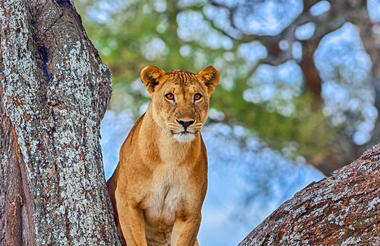
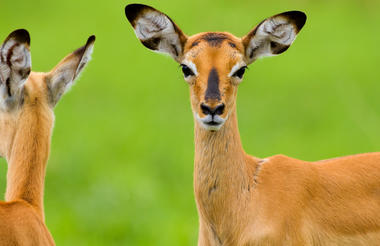
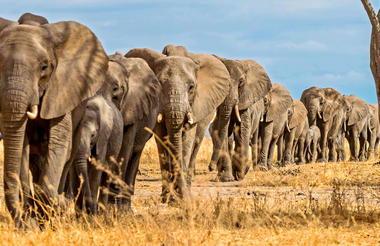
- NGORONGORO CRATER - SERENGETI NATINAL PARK
After breakfast, we Drive to Ngorongoro Crater and descend 600m into this magnificent crater for a full-day game drive. The Ngorongoro Crater is one of the most densely crowded African wildlife areas in the world and is home to an estimated 30,000 animals including some of Tanzania’s last remaining black rhinos. Supported by a year-round water supply and fodder, the Ngorongoro National Park supports a vast variety of animals, which include herds of wildebeest, zebra, buffalo, eland, warthog, hippo, and giant African elephants.
Another big draw card to this picturesque national park is its huge population of predators, which include lions, hyenas, jackals, cheetahs, and the ever-elusive leopard. We will enjoy a picnic lunch on the crater floor. You will be transferred to your Camp / Lodge Serengeti National Park for dinner & overnight Full Board
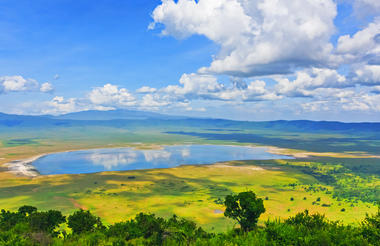
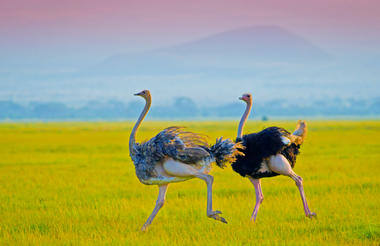
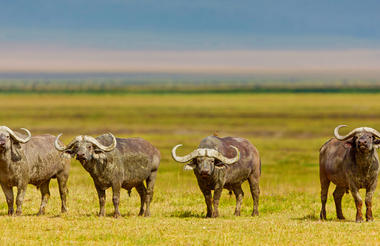
- FULL-DAY SERENGETI NATIONAL PARK
Sunrise game drive or Balloon Safaris, Be one of only a few fortunate people to glide in a Hot Air Balloon over the Serengeti Plains (available at supplementary cost by pre-arrangement). Floating silently above the awakening bush, while spotting wildlife and enjoying the amazing scenery of Africa, across rivers and over numerous small villages.
We do an after-breakfast game viewing drive along the Sogore River Circuit, which loops into the plains south of the Seronera River and is good for possible lions, Thomson gazelle, topi, ostrich, and cheetah sightings. The visitor’s center not far from the Serengeti Seronera Lodge and public campsites is well worth a visit after the morning’s game drive.
This nicely designed center offers some interesting wildlife displays as well as a gift shop selling information leaflets and maps of the area. The center also has a shop where cold drinks and snacks can be purchased and a picnic area and information trail up and around a nearby kopje. We will enjoy a relaxed picnic lunch at the center in the shade of the giant acacia trees.
We will follow the Kopjes Circuit in the afternoon, which goes anti-clockwise around the Maasai Kopjes, which usually attract several lions and some formidably large cobras. Kopjes are weathered granite outcrops, scattered around the plains, most of which are miniature ecosystems, providing shade and drinking water in pools left in the rock after the rains. This makes the kopjes particularly good for spotting wildlife in the dry seasons – including lions, which like to lie in wait for animals coming to drink!
You will be transferred to your Camp/Lodge Serengeti for dinner and overnight full board Included
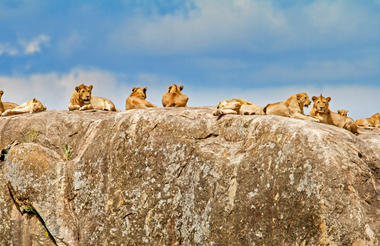
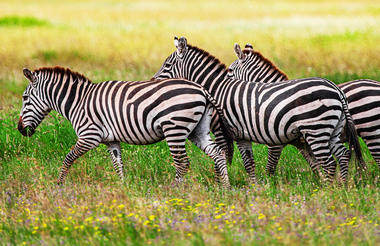
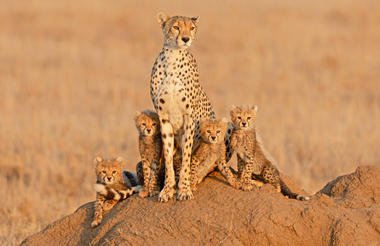
- FULL-DAY SERENGETI NATIONAL PARK
Sunrise game drive or Balloon Safaris, Be one of only a few fortunate people to glide in a Hot Air Balloon over the Serengeti Plains (available at supplementary cost by pre-arrangement). Floating silently above the awakening bush, while spotting wildlife and enjoying the amazing scenery of Africa, across rivers and over numerous small villages.
We do an after-breakfast game viewing drive along the Sogore River Circuit, which loops into the plains south of the Seronera River and is good for possible lions, Thomson gazelle, topi, ostrich, and cheetah sightings. The visitor’s center not far from the Serengeti Seronera Lodge and public campsites is well worth a visit after the morning’s game drive.
This nicely designed center offers some interesting wildlife displays as well as a gift shop selling information leaflets and maps of the area. The center also has a shop where cold drinks and snacks can be purchased and a picnic area and information trail up and around a nearby kopje. We will enjoy a relaxed picnic lunch at the center in the shade of the giant acacia trees.
We will follow the Kopjes Circuit in the afternoon, which goes anti-clockwise around the Maasai Kopjes, which usually attract several lions and some formidably large cobras. Kopjes are weathered granite outcrops, scattered around the plains, most of which are miniature ecosystems, providing shade and drinking water in pools left in the rock after the rains. This makes the kopjes particularly good for spotting wildlife in the dry seasons – including lions, which like to lie in wait for animals coming to drink!
You will be transferred to your Camp/Lodge Serengeti for dinner and overnight full board Included
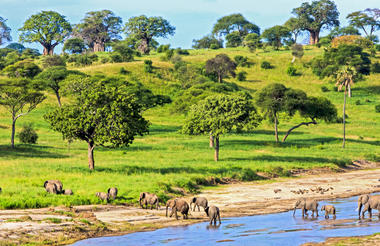
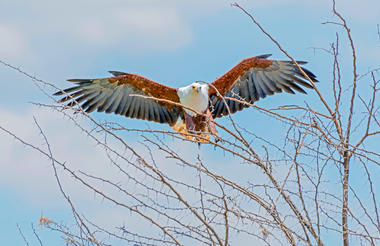
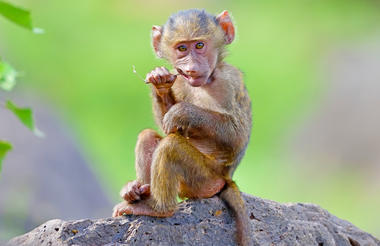
- SERENGETI - NGORONGORO CONSERVATION AREA
After breakfast at the lodge we depart for Ngorongoro Conservation Area, we will stop over at Olduvai Gorge, boasting a history dating back to the dawn of time. It was here, that the anthropologists Drs. Lois and Mary Leakey discovered the skulls of the Nutcracker Man’ and ‘Handy Man’, both very significant links in the chain of human evolution. We arrive in the afternoon at the lodge and spend the afternoon at leisure. You will be transferred to your Lodge for dinner and overnight Lodge full-board
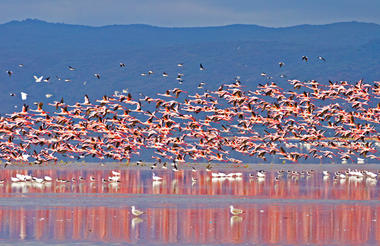
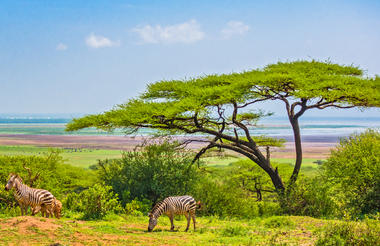
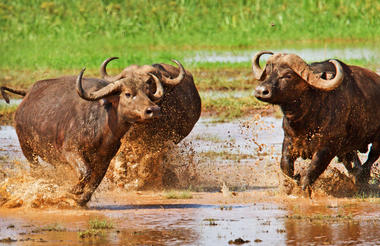
- All - Inclusive
- Alcohol
- LAKE MANYARA NATIONAL PARK - KILIMANJARO
Breakfast at 0700am. Pick up from the Lodge at 0800am and drive on tarmac with lunch box to Lake Manyara National Park 330 sq. km or 127 sq. miles on the base of the Great Rift Valley, for the Afternoon game drives. The park is home to Lion, Hippo, Elephant, Zebra, Buffalo, Giraffe, Baboon, Blue and Velvet monkey, Warthog and more. About 350 species of birds have been recorded. This small park contains also five distinct vegetation zones. Thus supporting a large variety of birds and animals. The Manyara National park is also famous for its large flocks of flamingos. In this park canoeing has recently been added to the tourist activities in this park at extra cost. This is a great way to see the park from a new perspective.
Later afternoon Drive to Moshi for dinner and overnight.
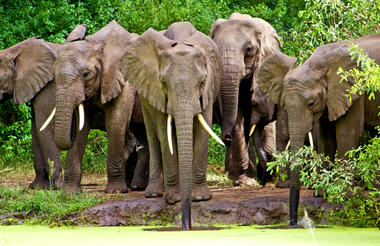
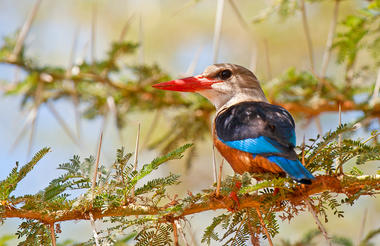
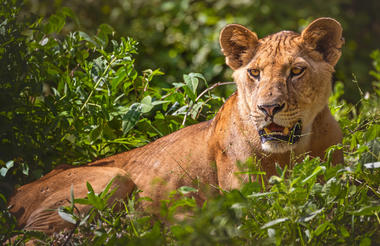
- AIRPORT TRANSFERS
The morning after late breakfast check-out and do your last shopping while waiting for your flight departure time.
- END OF ADVENTURE
- All-Inclusive
- Extra Day



